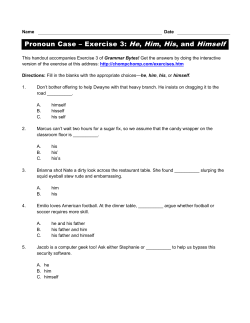
How Big Is Too Small?
May 2015 Picture Story Teacher Notes and Activities How Big Is Too Small? By Jane Godwin & Illustrated by Andrew Joyner Publisher: Viking Books/Penguin ISBN 9780670070756 $24.99 My brother was making a game with a ball, bouncing and throwing up high on a wall, when I asked to join in, he straightened up tall and I knew what he'd say, he said, 'you're too small.' Poor Sam! He always gets left out of his big brother's games. But one day when the big boys leave him out again, Sam gets to thinking...How big is too small? From these award-winning creators comes a delightful, rollicking story that explores big and small in a whole new way. Themes: Size Fitting in Acceptance Analysing Discussion Points: When you first read the title of this book, what did you think it would be about? Were you a little confused with the wording? Explore. Sam’s brother didn't want him to play because he was too small. Has something like this ever been said to you? If so, how did you feel? Do you think that Sam’s brother was being very fair? Sam showed a lot of analytical skills when he asked and then thought about the question ‘How big is too small?’ As a class, think of and then discuss some other questions similar to this one. Discuss the concept of ‘big’ and ‘small’. Do you think that everyone has the same opinion of what makes something ‘big’ and what makes something ‘small’? Explain. You may even like to have the children look up the meaning of each in the dictionary. Why did Sam’s brother see him as being useful to him when the ball got stuck on the roof? What can change your perception of size? Why did Sam’s brother suddenly look small when he was in the treehouse with his new friend? Do you think it was only because he was up high or could there be other reasons too? All that Sam wanted was someone to play with. What is it about having friends that makes us feel good? Activities: Make your own list of 10 ‘big’ things and 10 ‘small’ things. Compare the lists that each student has made and see how similar they are. Think of a group of similar things (like animals, forms of transport etc.) and then draw the smallest and the biggest within that group. © Copyright Lamont Books Pty Ltd 2015. These notes may be reproduced in schools for educational purposes only.
© Copyright 2025





















